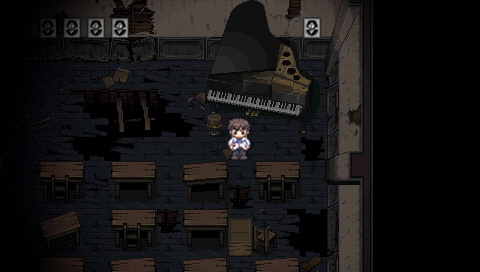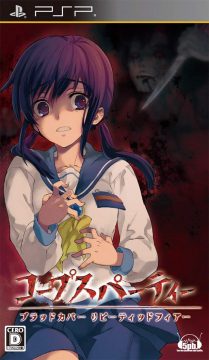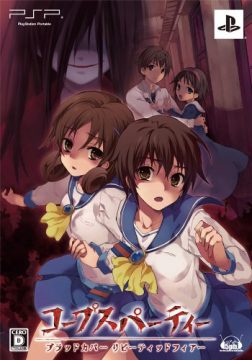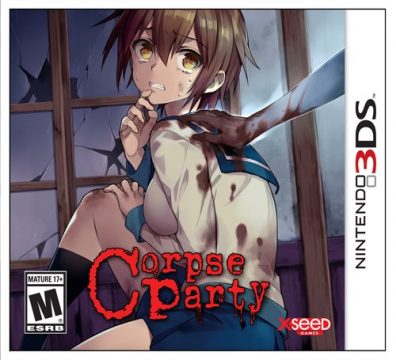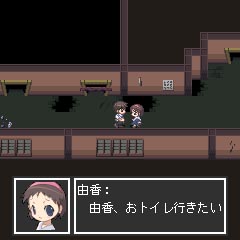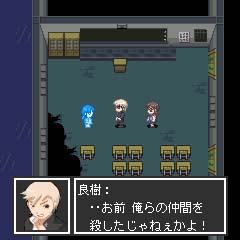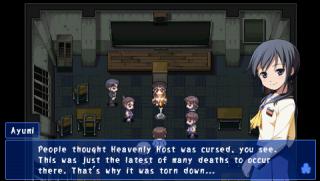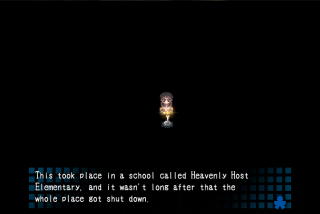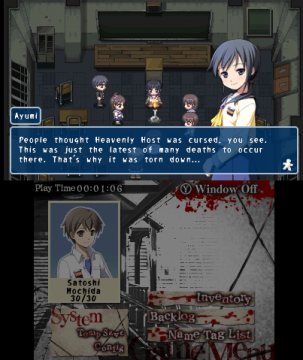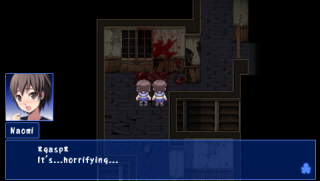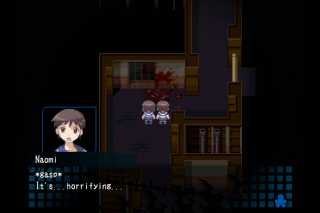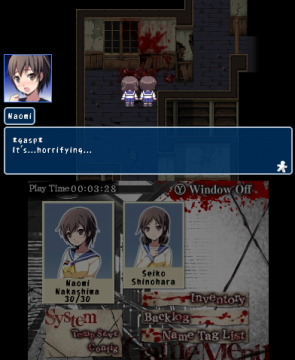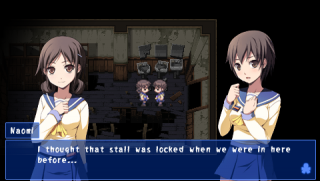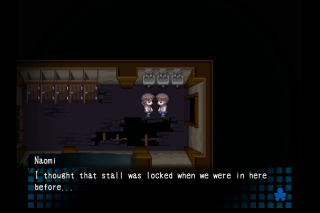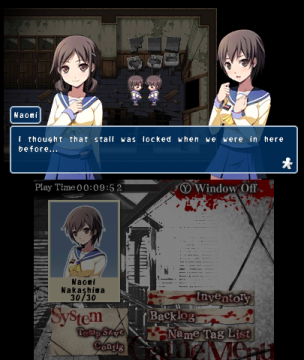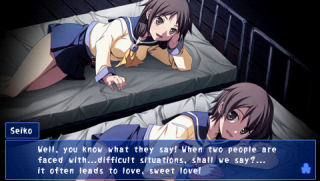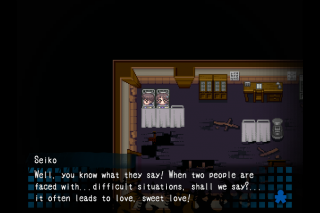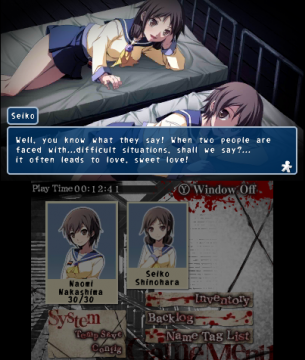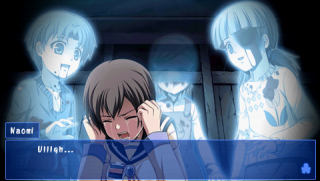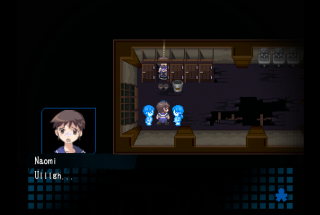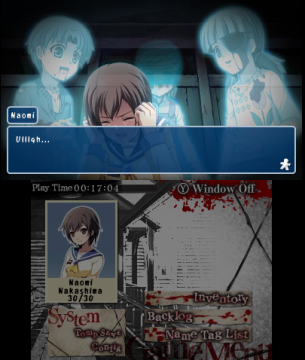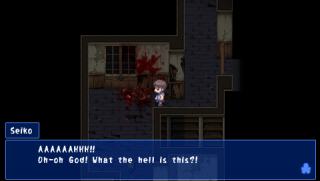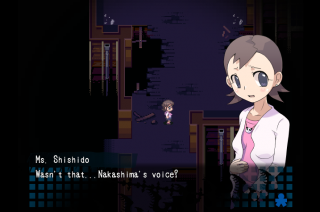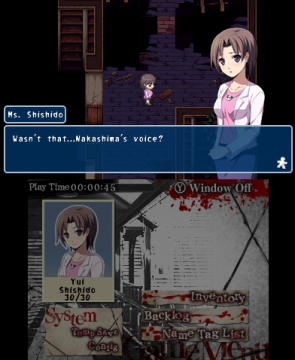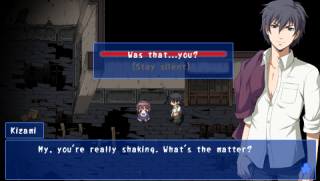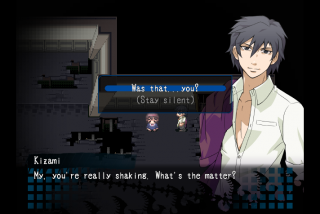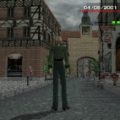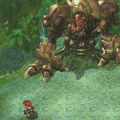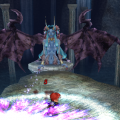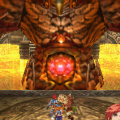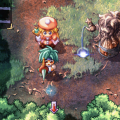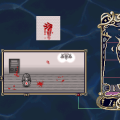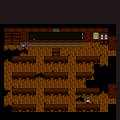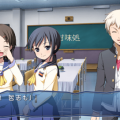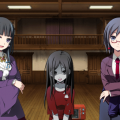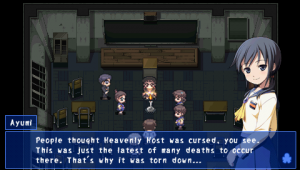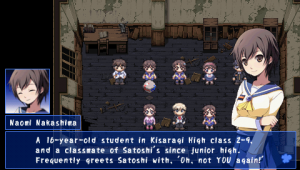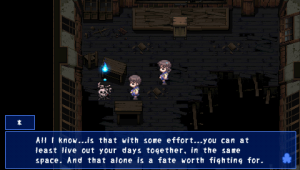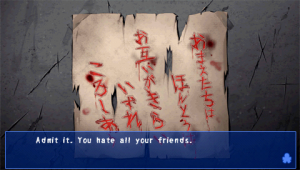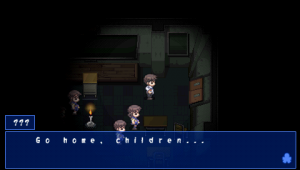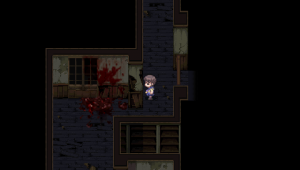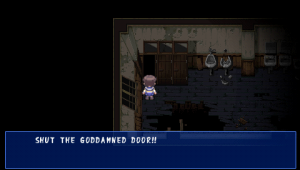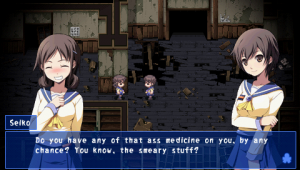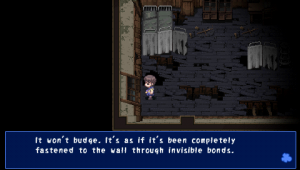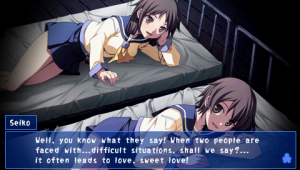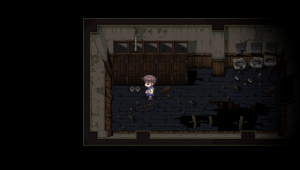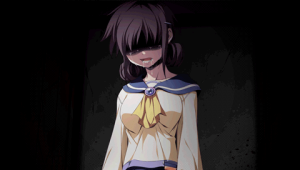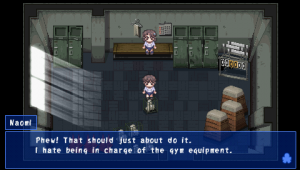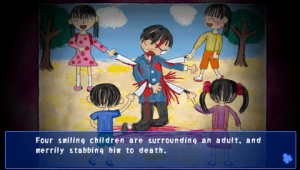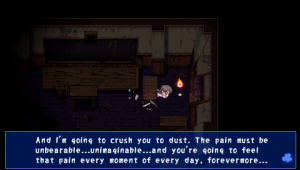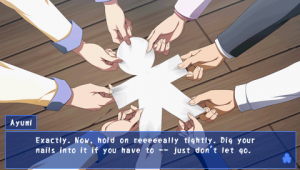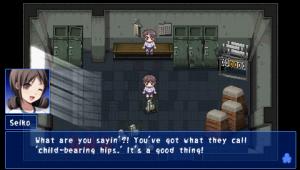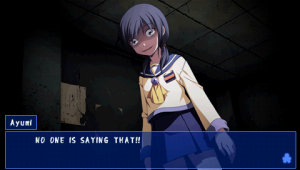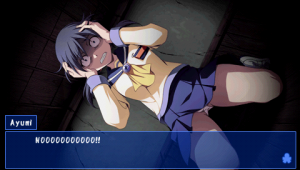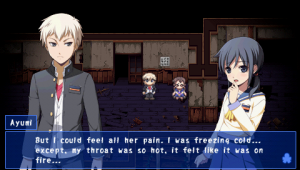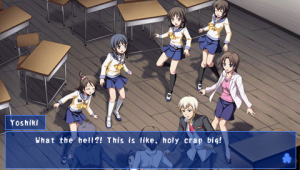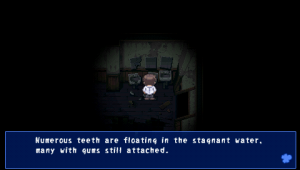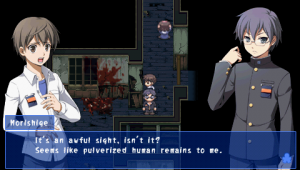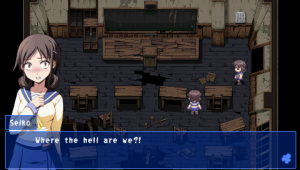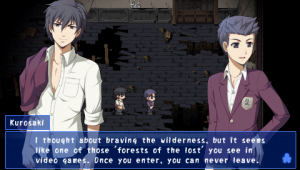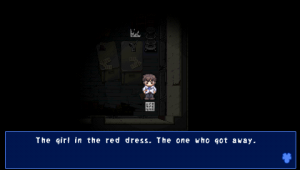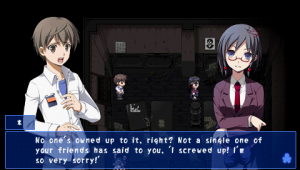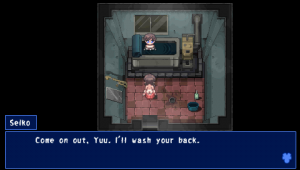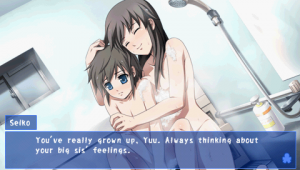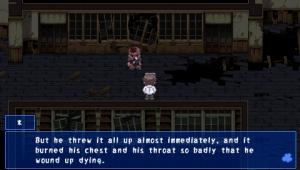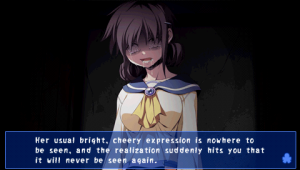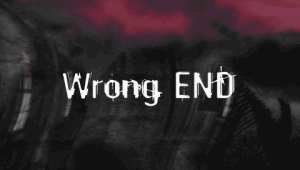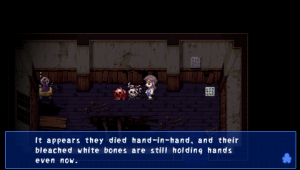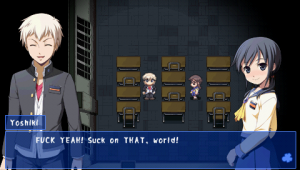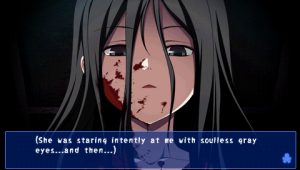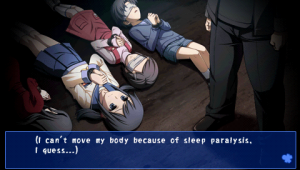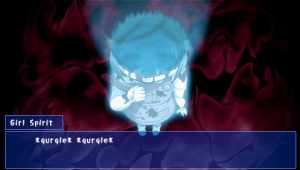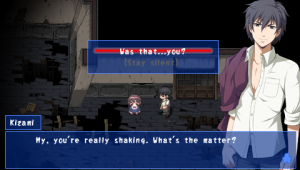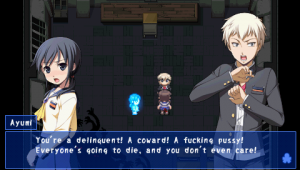Rather than handle development of a new Corpse Party on his own, Makoto Kedouin formed a doujin studio known as “Team GrisGris”, and gradually began work on a reboot of the original game. The end result is known today as Corpse Party: Blood Covered in Japan, but simply Corpse Party internationally, as international audiences were meeting the series for the first time. Despite the title change, international fans tend to use the Blood Covered label to tell the game apart from its fellows.
Blood Covered is the series’ golden child, its most popular and critically respected entry, and the start of a new canon that continues to the present day. Even the layout of Heavenly Host Elementary, the evil school, has remained consistent ever since, setting aside the school’s ability to make minor changes to floors and doors to vary up the gameplay of each chapter.
The introductory story is only slightly modified, but in the long run the player will see significant narrative changes. The story now begins with the extended cast of nine gathered to celebrate their last day at school with a beloved classmate. To mark the occasion, Ayumi produces a “magic charm” called “Sachiko Ever After”, which is supposed to unite the participants as friends for life. Unfortunately, after the party performs the charm, they are pulled into the otherworldly dimension of Heavenly Host Elementary.
Blood Covered sees a much expanded cast that will go on to appear throughout the new series, in addition to the cast from CORPSE-PARTY.
Seiko Shinohara
Naomi’s best friend. Deliberately crude and an exaggerated pervert, Seiko is responsible for some of the English version’s most infamous lines of dialogue, but a lot of the players who stick around seem to have to fallen in love with her.
Mayu Suzumoto
A self-sacrificing junior saint, Mayu has empathy for everyone, even – as it turns out – the ghosts of Heavenly Host. She’s the one who’s moving away at the start of the game, making her the accidental impetus for everything that follows.
Sakutaro Morishige
A would-be stage actor, Morishige resents a lot of the social rules and cliques that have kept him out of the spotlight. Once he arrives in Heavenly Host, he finds himself free of those oversights, which begins to manifest in the form of some strange behaviour. Best friends with Mayu, he insists on locating her above all else.
Yui Shishido
The cast’s English teacher, Miss Yui is young and just out of school herself. She’s determined to live up to her ideals as a teacher, and to protect her students when the supernatural events begin to strike.
Naho Saenoki
An occult wunderkind in love with her mentor, Naho arrived at Heavenly Host long ahead of the party, and died there. She now lingers as a ghost, still looking for her beloved.
Yuuya Kizami
Part-way through the game, the cast meets another group of students. Yuuya is the most prominent of the group, a helpful yet aloof young man who ends up teamed with Yuka. But looks can be deceiving…
And this is just the central cast. Blood Covered also introduces a whole pile of victims and satellite characters, most of which would be expanded in the game’s “Extra Chapters” or in later entries of the series. Blood Covered‘s cast is so large, in fact, that the narrative has to start making excuses in the form of supernatural elements. Now characters are broken up into “alternate” versions of the demon school, like parallel dimensions, which leaves them more isolated than in the original. The Sweet Home-style gameplay of swapping between teams at will is now mostly gone as a consequence, though it makes a return in the game’s final chapter.
All this extra room is put to good use, as Blood Covered breaks up the non-stop parade of horror set pieces from the original and spreads them apart. This helps Heavenly Host feel more like a real, hellish place and less like a haunted house attraction, with a pop-up mummy three steps away from a vampire. Blood Covered‘s stock-and-trade is still in shock horror, but it also likes to disturb the player, and it needs these lulls to pull it off. The game uses found documents to describe the experiences of other victims. These notes tend to focus on slower horrors to add to the mood: starvation and cabin fever are constant background threats, and add to the sense of imprisonment. Some notes tell interconnected mini-dramas. In short, Heavenly Host isn’t happy just killing its victims, it wants them to be uniquely miserable before their sudden, violent ends. Some unfortunate victims of these slow tortures suffer from a supernatural ailment known as “the darkening”. While darkening is purely narrative in Blood Covered, it would go on to become a dedicated mechanic in two of the sequels.
One of Blood Covered‘s major successes comes in the way it seems to care about its characters. Nearly every character gets detailed characterization and backstory, some of them even after their death, to underline the tragedy. While the game has a lot of frivolous “Game Over” situations, the “True” losses can feel tragic and irreplaceable, sometimes even cruel. At the same time, this can add to the player’s incentive to get the rest of the party out alive.
Gameplay is much the same as in the original CORPSE-PARTY, including the mostly-automatic puzzles, and more branching dialogue options. Nearly all the RPG elements from the original are now gone, save for the HP system. The HP system probably should have gone with them, as it’s only used three times in the entire game. Also present are multiple “chaser” enemies this time around, including three murderous ghost children and Sachiko’s favourite henchman, a hulking, hammer-wielding zombie. Unlike the anatomical model in the original CORPSE-PARTY, Blood Covered‘s chasers behave in the modern fashion for the genre: relatively close in speed to the player, and they can only detect the player within a radius. This makes them more of a dexterity challenge than a puzzle.
Blood Covered is fairly heavy on the text compared to the original game, virtually a Visual Novel. Unfortunately, most versions of Blood Covered are missing almost all the comforts of modern VNs: there are no backlogs, no “auto” feature to progress the text automatically after the voice acting is done, and most versions of the game lack a text skip. At least the game gives you the VN-style ability to hide the text boxes to get a better look at the art! The game also backslides from the PC-98 game in forcing you to use save point candles instead of saving from the menu. Thankfully, all versions have a temporary Save and Quit / Suspend option.
Blood Covered‘s dialogue writing and localization is generally good, although the XSEED localization did include a few lines that live on in infamy. Depending on version, dialogue in Blood Covered may be voiced in Japanese, but narration is always silent. This narrative silence may be appreciated, as the game kills characters with gruesome detail. The original PC release also tends to present deaths in text only, with a black (or red) background replacing the visuals. This isn’t true of remakes, which present CGs attached to every character death. The CGs in this series have a mishmashed approach to gore: one scene might obscure the violence while another goes whole hog with viscera, and there doesn’t seem to be any governing principles as to what was and wasn’t acceptable.
Unlike the original CORPSE-PARTY, the player won’t be able to get through Blood Covered without losing a few characters, even down the “True” path. In addition to these canon deaths, Blood Covered also features a number of “Wrong Ends” that occur chapter-to-chapter instead of waiting for the end of the story. Some Wrong Ends are tied to explicit mistakes, but others are almost gags. Generally speaking, Wrong Ends occur the moment you screw up, making it easy to identify your mistake. Unfortunately, there are Wrong End that take time to strike, and they can easily confuse the player. In one case, the belated Wrong End is a “Dead Man Walking” situation where the game is waiting for you to inadvertently select from two deaths, but most of these “long” Wrong Ends take place in Chapter 5, where they carry on until the end of the story in reference to the 1996 game. One such ending, Chapter 5 Wrong End 2, deserves special contempt. This is the “everything goes wrong” ending, and it cuts out every part of the chapter that doesn’t fit its drastic changes. This includes nearly all gameplay, leaving you with what’s essentially an hour-long cutscene that’s full of plot holes!
For what it’s worth, the game keeps track of your Wrong Ends. Anyone going for 100% completion will want to step into a few meat grinders, so it won’t hurt if some happen by accident. Unfortunately, some of the game’s Wrong Ends don’t seem to happen for logical reasons. The first chapter will kill you for not reading a newspaper in an entirely different part of the school. In the second, a deathtrap will kill you if you’re alone, but literally doesn’t exist if you have a companion!
In addition to the hunt for Wrong Ends, Blood Covered also adds an unspoken sidequest in the form of student nametags found throughout the school, usually next to their deceased owners. By collecting these, the player can go to the menu to read a small snippet of the victim’s history. There is no in-game reward for collecting all the nametags, but they do add to the atmosphere. It’s too bad the game hides the details of each nametag on the menu screen, which is sorted by school for some reason, which means you have to track down the victim’s tag every single time you want to read the cause of death.
In addition to the main storyline, Blood Covered contains “Extra Chapters”, which are unlocked as the player completes the main story. The Extra Chapters allow the game to tell side stories without disrupting the main narrative. Unfortunately, the Extra Chapters are also the biggest source of discrepancy between different versions, as discussed in more detail below.
Blood Covered‘s release history is confusing, and no version can be considered “definitive”. Development of Blood Covered began on cell phones as Corpse Party: New Chapter in 2007. Each chapter was originally released for free, but the game was cancelled at some point after the release of episode 4 out of 5. New Chapter seems lost today, and what little is known about it has to be deduced from promotional screenshots. Some, but not all, of the game’s maps were smaller than their modern incarnations, seemingly designed to fit rooms onto a single screen whenever possible. New Chapter‘s narrative and gameplay is believed to be similar to the modern episodes 1-4, although this can’t be confirmed outside of the screenshots mentioned above.
As the developers moved to Windows and a commercial release, the game’s title was changed to Blood Covered. Two episodes were made available at launch in 2008, and were quickly followed by a third, but the fourth took nearly half a year, possibly due to the development of the PSP release, below. The Windows version was the first to see the addition of voice acting, although it typically only appears in major scenes. These four chapters were accompanied by three Extra Chapters. This initial set of Extra Chapters is brief, but features some light gameplay.
At this point, even though the game was still incomplete, publisher 5pb. Games bought up the rights to distribute the game on PSP, retitled Corpse Party: Blood Covered …Repeated Fear. The PSP version saw full release (all five episodes) in 2010, and was released in North America and Europe as by XSEED in 2011 as Corpse Party. This version only saw release via the Playstation Network. The PSP version formed the basis for the iOS port released in 2012 (JPN) and 2014 (NA/EU). While there are obvious differences in controls, the PSP and iOS versions are nearly identical. The iOS version does have additional bug fixes, including a fix for a missing nametag.
The PSP/iOS game features updated music, improved portrait art (which is more frequently used instead of the busts favoured by older versions), as well as new portraits for certain minor characters that lacked them. The game also improves the sprite of one of the antagonists, a headless child-ghost, by giving her a “glow” where her head should be, making her condition obvious at a glance. The PSP version added a whole seven Extra Chapters on top of the original three. Unfortunately, gameplay is sparse in these Extras: they are full Visual Novels, and quite short. The PSP/iOS version also saw the introduction of CGs, including CGs for most of the game’s Wrong Ends, although it lacks a CG Gallery.
One of the biggest features in the PSP release was full voice acting using a new cast. The 5pb. Games voice actors are much bigger names than the cast hired for the original PC release, and several cast members are career singers with connections to 5pb. Games’ sister company, 5pb. Records. Naturally, some of these singers were employed to provide the songs for the game’s opening and closing credits. Voice actresses Asami Imai (Ayumi) has songs in most of series’ games and spinoffs, sometimes teaming up with Eri Kiamura (Yuka) as part of their pre-existing joint act, ARTERY VEIN.
On the subject of voice actors, the character of Sachiko – the sadistic, murderous ghost girl – is a played by Ikue Ohtani, the voice of Pikachu!
It was only after finishing the PSP game that Team GrisGris returned to finish Episode 5 for the PC in 2011. This revised Episode 5 features full voice acting instead of the partial voice acting of past PC episodes (using the pre-existing PC voice cast), a new puzzle sequence and associated Wrong End, as well as a greatly extended Wrong End which branches into two endings reminiscent of the original CORPSE-PARTY. Unfortunately, Team GrisGris did not back-port the new seven Extra Chapters from the PSP release.
The collected PC version saw a curious English release in 2016, which can be found on the major digital platforms. Besides translating the PC-exclusive endings and sometimes-variant text, this version adds a few features: modern joystick support, achievements on Steam and GOG Galaxy, and text skip feature. Like the original PC release, the 2016 version includes only the original three Extra Chapters. On the other hand, it features an exclusive “Extra Preview”. This preview is actually a chapter from Book of Shadows, retrofitted into Blood Covered‘s gameplay. The developers added some specially-made gameplay elements to the chapter while they were at it, putting your HP gauge to use for once, as you dodge arrows and maze your way through puddles of slime. While the gameplay is novel for the series, this preview chapter is hardly a “must play”, especially considering its story can be experienced in the sequel.
In 2015, 5pb. Games revisited Blood Covered by releasing it on the 3DS. The 3DS version got an international release in 2016, primarily on the 3DS e-Shop, though a limited edition “Back to School” edition was also released with added merch. This “Back to School” edition stands as the only physical, English release of Blood Covered to date.
The 3DS version is mostly based on the PSP/iOS releases, complete with iOS bugfixes, but uses new, higher-resolution sprites, adds animation to some CGs (not always desirable, but not bad either), and also adds two of the VN features missing from the original: a text skip and a backlog. Unfortunately, the backlog is only available outside of dialogs, which partially defeats the point. The game even conveys your HP on the bottom screen for the whole three instances where that matters. This version also adds new character profiles, a CG gallery, and four new Extra Chapters, for a total of fourteen. These Extra Chapters are arguably the best in the lot, being quite sizable (in the neighbourhood of 20-25 minutes each for the first three) and having some measure of gameplay. Two of the four 3DS chapters were originally free DLC in Japan, but the international release includes all four by default.
The 3DS version also added a new Wrong End to Chapter 1, and also incorporates the puzzle sequence that Team GrisGris added to the PC release of Episode 5. Unfortunately, the 3DS version does not include the PC version’s extended and branching Wrong Ends. Curiously, most of the new content on the 3DS is unvoiced, but the puzzle sequence borrowed from the PC version is fully voiced, implying that 5pb. Games may have been intended it for inclusion in some earlier version, only for it to be dropped.
Overall, the 3DS version is the most complete version available, but it comes at nearly double the price for less than double the content. The PC version has its own unique content, but is nearly the same price as the PSP and iOS releases outside of a Steam sale, despite the fact that it’s missing game-wide features and essentially eleven Extra Chapters. Someone willing to buy both the 3DS and PC versions would have access to all content, but only a hardcore fan would bother. Ultimately, the PSP/iOS version is probably the best version for a value shopper: it’s missing some content, but its core experience is polished without having to pay through the nose for the 3DS version.
Links:
New Chapter Official Site (JP)
Blood Covered PC Official Site (JP)
